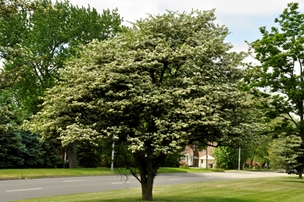
enlarge this imageThere are plenty of hawthorns along our roadways. Some are deliberately planted (such as English Crataegus laevigata, and the native Washington- and cockspur hawthorns, C. phaenopyrum and C. crus-galli) and many find their own way in from nearby natural areas (downy-, dotted- , glossy- and frosted hawthorns, C. mollis, C.punctata, C. nitida, C. pruinosa).
They catch your eye
Once you catch a whiff, your nose may know them as well
Tis the season of white trees, purple groundcover and phlox-like
patches along the road.
Hawthorn trees (Crataegus species) and catmint
(Nepeta species) are common highway plantings because
they're attractive and tolerant of roadside conditions --
pollution, heat and drought.


The hawthorns' dense crowns help with noise suppression.
There's an Old World saying, "It's bad luck to approach a
hawthorn tree at night." To that, we pose a New World saying, "Duh,
you think?!" (Below, cockspur hawthorn leaf and thorn, C.
crus-galli)

Catmints' ground-smothering habit helps control roadside weeds.
If your window's open and traffic's slow you might catch the
hawthorn flowers' scent, which can be somewhat fetid. Perhaps the
catmint's more pleasant smell will make up for it.



Sweet rocket (Hesperis matronalis, also known as dame's
rocket) is an Old World import that escaped to the New World wilds.
It's biennial and its seed readily colonizes almost any kind of
disturbed ground. Sweet refers to its fragrance, most notable late
in the day, and dame to its historic medicinal uses for "female
troubles."


Some people call it wild phlox based on its stature and
flower form, although sweet rocket is a 4-petal mustard family
member, not related to the 5-petal tall phlox gang.
